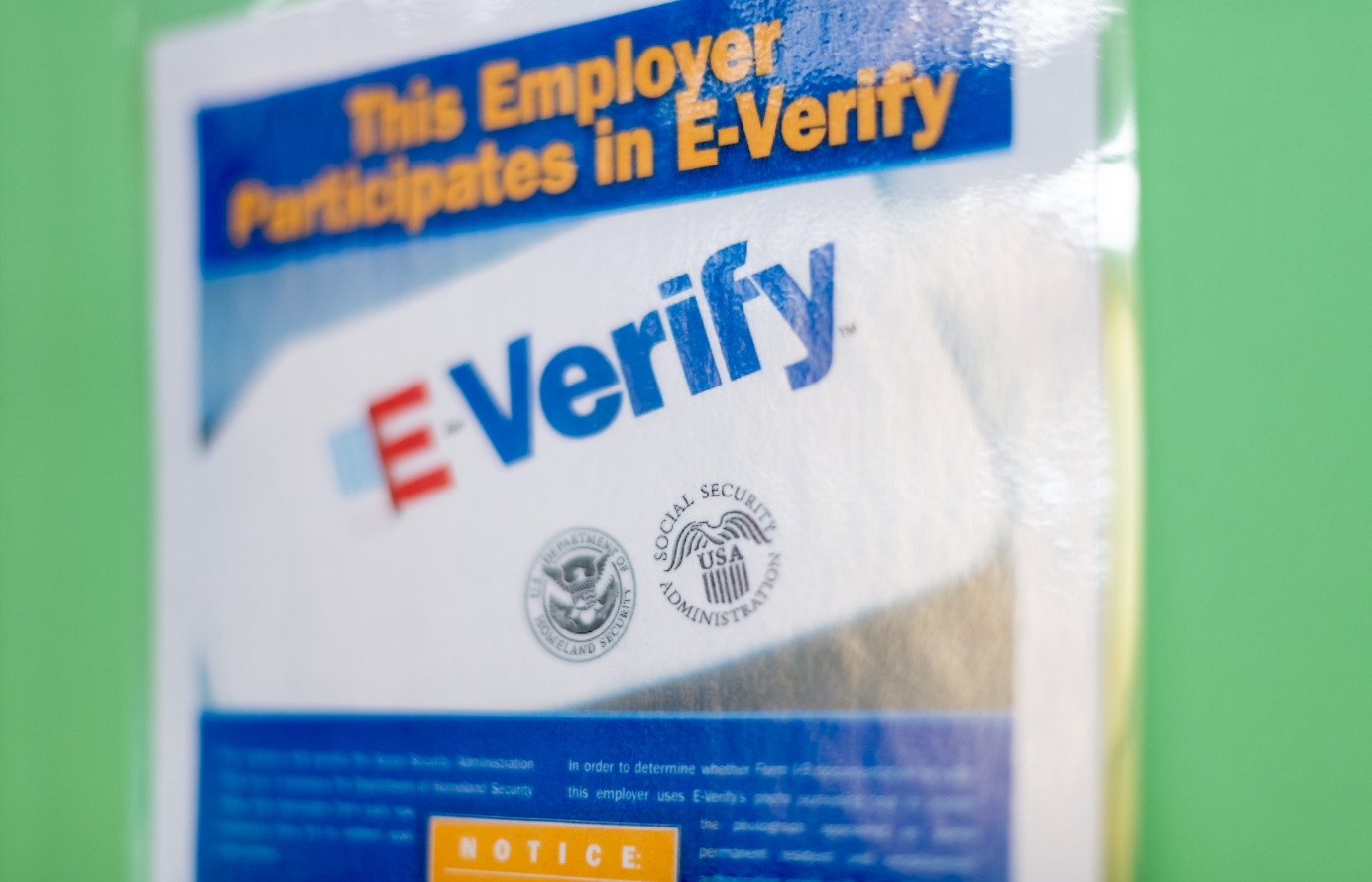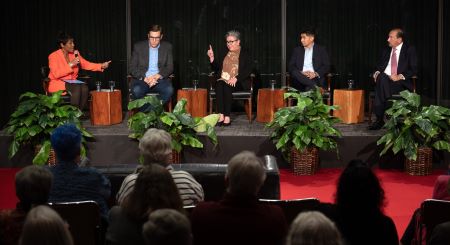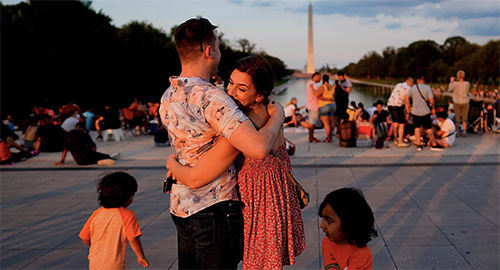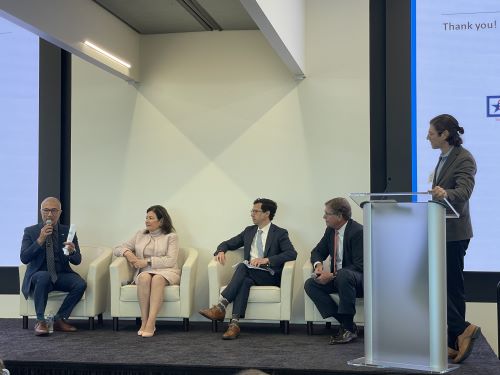One Solution to the Immigration Debate
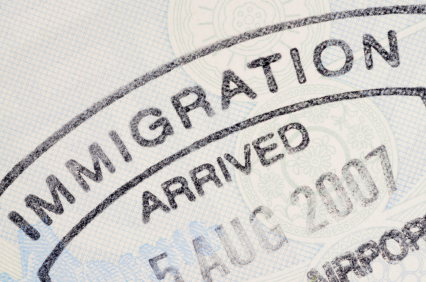 Conservatives are torn over the issue of legalization for illegal immigrants. Some, like Sen. Marco Rubio, support a path to citizenship for many illegal immigrants, while others, like political scientist Peter Skerry, support legalizing them without a path to citizenship. A third group of conservatives opposes any and all efforts to legalize illegal immigrants in the United States. These groups have stalemated into three intellectually armed camps under the constant watch of a near-unified liberal opposition that supports legalization with a path to citizenship for virtually all illegal immigrants.
Conservatives are torn over the issue of legalization for illegal immigrants. Some, like Sen. Marco Rubio, support a path to citizenship for many illegal immigrants, while others, like political scientist Peter Skerry, support legalizing them without a path to citizenship. A third group of conservatives opposes any and all efforts to legalize illegal immigrants in the United States. These groups have stalemated into three intellectually armed camps under the constant watch of a near-unified liberal opposition that supports legalization with a path to citizenship for virtually all illegal immigrants.
The Senate’s immigration reform bill in 2013 included a one-size-fits-all legalization that was the focal point of political opposition. Despite the opposition, that legalization plan would have legalized only about 70 percent of illegal immigrants, according to the Congressional Budget Office. Other proposals for immigration reform and legalization have failed continuously over the last decade. But a better path toward legal status and an easier political debate over legalization are possible.
The policy preferences of path-to-citizenship conservatives and legalization-without-citizenship conservatives can be combined into one reform package that will outweigh opposition by the anti-legalization conservatives and attract liberal support. The reform idea proposed here is a three-tiered legalization system that allows otherwise law-abiding illegal immigrants to individually choose for themselves whether they want to be on a path to citizenship or just want permanent legal residency without the option to naturalize. Instead of a one-size-fit all legalization program, which has failed to pass Congress every time it has been proposed since 2001, a three-tiered plan would allow illegal immigrants to pick for themselves and be politically viable with liberals and pro-reform conservatives.
We are debating immigration legalization because American immigration law is schizophrenic. On one hand, social reformers want to centrally plan and manage the inflow of immigrants. Laws supported by these reformers are quixotic and assume the government has the incentive, ability and information to accurately and wisely determine which immigrants should come here and what skills they should have. Complementary to that hubris is an undeserved confidence that the new immigration laws will actually be followed. The late labor historian, economist, and immigration restrictionist Vernon M. Briggs Jr. found that illegal immigration is a result of U.S. immigration restrictions that were unrealistic given American demand for immigrants and were never properly enforced despite desperate efforts to do so.
On the other hand, Congress has forgiven illegal immigrants for breaking American laws on several occasions. Every major immigration reform in the 20th century was accompanied by legalization. The Immigration Act of 1924 that closed the borders with Southern and Eastern Europe and tightened them with Asia was followed by an amnesty in 1929. The administration of the Bracero Program from 1942 to 1964 granted numerous work permits to illegal immigrants, but not a path to citizenship. Another amnesty was again passed in 1958. The Immigration Act of 1965 and the Immigration Reform and Control Act of 1986 also amnestied illegal immigrants, the latter being the largest by far.
This cycle of reform followed or accompanied by legalization will repeat itself, but the form that this takes is still up for debate. The no-legalization portion of the conservative movement will continue to delay reform but public opinion is steadily moving against them. If conservatives want to shape any future legalization or, better yet, take credit for it, I propose a three-tiered legalization scheme that can unite pro-reform conservatives, earn a lot of liberal agreement, and gain the support of much of the immigrant rights community.
It is important to understand the characteristics of illegal immigrants before detailing this new reform idea. The Pew Research Center carefully studies the characteristics of illegal immigrants. The center estimates that in 2012, there were about 11.2 million illegal immigrants who comprised 3.5 percent of the U.S. population, 26 percent of all immigrants, and 5.1 percent of all workers. Illegal immigrant men were more likely to be employed than native or legal immigrant men, but the opposite was true for women. They are lower-skilled and have lower household incomes.
More than a third of unlawful immigrants lived in California and Texas. Forty-seven percent lived in households with children compared to 21 percent of U.S.-born Americans. Up to 16.6 million people, including the U.S.-born citizen children of illegal immigrants and their legal spouses, live in a household where one immediate family member is an illegal immigrant. Eighty-one percent are from Mexico, Central or South America and the Caribbean. As of 2011, 85 percent of illegal immigrants have resided in the United States for more than five years, while 63 percent have been here for 10 years or longer.
Three-tiered legalization
The tiered legalization process I propose contains three different options available to otherwise law-abiding illegal immigrants. Under this plan, the individual illegal immigrant could choose one path to legal status and could not switch to another at a later date, except maybe by paying an enormous penalty. This plan assumes no other changes in the immigration laws, no enforcement triggers that would have to be met before legalization could begin, and no regulations that would bar the immigrant from getting a green card through marriage or military service.
- The first path is a work permit. This allows the illegal immigrant to work, travel and live in the United States legally. This visa should require a small initial fee of $100, plus the paperwork costs, and a renewal fee of $25 every two years so long as the worker is residing in the United States and complies with the terms of the permit. If the worker decides to move outside the United States, then he should have the ability to return with this permit upon payment of the renewal fee. If he decided to return to his home country for years, he can retain the ability to come back and work legally in the future. The migrant will lose the permit and be deported if he is convicted of a crime. This permit will not allow the legalized immigrant to sponsor any family members to immigrate and he or she is permanently barred from all means-tested welfare benefits.
- The second path is permanent non-citizen residency very similar to that proposed by Skerry. This is a green card in every sense except that it does not allow the immigrant to become a citizen. He or she can live, work, travel, sponsor immediate family members for real green cards, and purchase firearms but not naturalize. The fee should be the same as a green card — $1,070 — and it should be renewed every 10 years like the green card. Permanent non-citizen residents should not have access to means-tested welfare programs until they renew it for a second time. At such point, the immigrants in this category should have the same limited access as green card holders who have resided in the United States for more than five years, dependent upon their state of residency. Permanent non-citizens convicted of serious felonies or a series of misdemeanors, like current green card holders, will be deported after their imprisonment.
- The third path should eventually lead to citizenship. It should begin with a registered provisional immigrant status that costs $1,070, denies the owner access to means-tested welfare and is similar to the legalization provision in the 2013 Senate bill. The provisional immigrant permit transforms into a normal green card after the immigrant passes an English fluency exam, takes a series of American history and civics classes, has lived continuously in the United States for five years, has shown steady employment, and has found a number of American citizens who know him and can attest to his willingness and desire to become an American citizen. If the provisional immigrant does not fulfill any of those requirements in a decade or changes his mind, he should be granted permanent non-citizen residency under the second path. If he does fulfill the requirements, he would have the option to pay another $1,070 to gain a normal green card that would eventually lead to citizenship if the immigrant chooses to naturalize and follow the terms of residency.
Each path to legal status has a different series of benefits and costs. The work permit is the cheapest, but also the most limiting. The permanent non-citizen residency option is more expensive, but allows for the immigrant to sponsor additional immediate family members to immigrate. The green card is the most expensive and can eventually allow the immigrant to become a citizen and participate in America’s political system. Crucially, this system will work only if switching between these tiers is not allowed, except for a large fee.
This legalization plan would satisfy conservatives who support citizenship and the Skerry wing who support legalization without citizenship. Illegal immigrants overwhelmingly come here for economic opportunity, so most would choose a work permit or permanent non-citizen residency. Those options are much cheaper and offer almost all of the economic benefits as a green card without a path to citizenship. After the 1986 amnesty, only 45 percent of the newly legalized immigrants even chose to become citizens by 2009, showing that they were happy with their green cards because it allowed them to legally work and live as they please without the fear of deportation. If the cheaper permanent non-citizen residency or work permit options were available in 1986, then even more of the amnestied immigrants would have chosen it. The lesson from this is that the path to citizenship component of the green card is the least valuable portion of that document while the legal work authorization, ability to travel, and family sponsorship options are most important.
However, a work permit or permanent non-citizen residency are not enough by themselves. Some illegal immigrants want to become American citizens, especially Dreamers who were brought here at young ages and grew up in the United States. Legalization without the option of citizenship is politically unstable for them. If illegal immigrants who want citizenship are legalized, but cannot even become citizens, then they will politically agitate, lobby and eventually succeed in earning citizenship for themselves — probably with the help of left-wing groups who currently favor a path to citizenship.
There are roughly 56,000 residents of American Samoa who are non-citizen nationals of the United States and there is no large-scale political movement to grant them citizenship. But that is a paltry number compared to the 11.2 million illegal immigrants in the United States. Millions of green card holders are eligible for citizenship but they choose not to apply. They actually have the choice to do so, which makes the system work. Past or current experiences with non-citizens are inapplicable to a mass-legalization without the option for eventual citizenship.
If this plan is adopted, some illegal immigrants will initially choose the work permit or permanent non-citizen residency option, but then seek an upgrade to a more expensive path. To satisfy liberals who will be sympathetic to those who change their minds, there should be a way for them to move from a non-citizenship path to a green card. To satisfy conservatives, moving from a non-citizenship path to a citizenship path should be more expensive and difficult than the three simple paths laid out here. There should be other requirements for upgrading, such as close family ties in the United States, the recommendation of numerous American citizens, English fluency and work requirements. An immigrant who chooses to downgrade, say from the path to citizenship to permanent non-citizen residency or a work permit, should be compensated for the difference in price.
Objections and rebuttals
Political coalitions, with the exceptions of anti-legalization conservatives and citizenship-for-everybody liberals, will be satisfied by this three-tiered approach. Pro-citizenship conservatives should be satisfied because there is an option for illegal immigrants to naturalize. Conservatives who favor legalization without citizenship will be satisfied because the majority, possibly an overwhelming majority, will choose the legalization options that do not lead to citizenship. Thus, conservative fears that legalized immigrants will eventually form an impenetrable Democratic voting bloc will be severely attenuated.
Current illegal immigrants will be happy with this three-tiered system, too. Those illegal immigrants who want to become citizens can do so by following a more expensive route to legal status, while those who just want to work, live and travel to and from the United States legally can do that. Pricing a pathway to citizenship higher than the other options allows the individual immigrant to pick his future level of involvement in the political and economic system of the United States. Most importantly, the choice would be up to the individuals involved — something denied by every other proposed one-size-fits-all legalization plan. The three-tiered legalization is also an improvement over the current system, even taking into account President Obama’s executive actions to temporarily legalize some illegal immigrants. The resident’s actions are temporary, only cover a fraction of the unauthorized immigrant population, and can be overturned by the courts or the executive actions of the next president. A three-tiered solution passed by Congress would resolve those concerns.
Most liberals, with the exception of the citizenship-for-everybody wing, would also be satisfied because the immigrant community would be satisfied. This three-tiered plan would cause a fissure between liberals in the citizenship-for-everybody lobby and other liberals, but it would not be enough to fracture their coalition. Although most of the legalized population would not choose the path to citizenship, those who want to will be able to do so. Several private liberal and immigrant rights groups would likely mobilize to convince many of the legalized immigrants to choose the green card path to citizenship option.
Legalization does not need to be limited to two choices: legalization with a path to citizenship or no legalization at all. Among illegal immigrants, there is a range of skills, ambitions and desires for citizenship. The current legal immigration system allows a range of dozens of different visas for those seeking to come to the United States. Although those legal options are too limited given American demand for immigrants and their desire to come, they do include many work and student visas that do not lead to citizenship while others do. A legalization program for illegal immigrants that creates a similar range of choices will better satisfy both the immigrants and many political coalitions better than a single option.
Individual illegal immigrants choosing one of these three options for themselves, and sticking with their choice, is the key to a sustainable legalization system. On one hand, conservatives for legalization, but not citizenship, are right that most illegal immigrants do not want it although a loud minority does. Citizenship-for-everybody liberals, on the other hand, want a path to citizenship for illegal immigrants despite only some of the immigrants themselves actually demanding it. Instead of the government choosing for everybody, Congress should create three options and let the immigrants choose for themselves.
The U.S. immigration system is too restrictive and enforcement alone will not solve the problem despite numerous attempts to beef up security. Millions of unauthorized immigrants are the result of this poorly functioning system. Many people think that the U.S. government should not legalize people who broke our immigration laws. Those laws and the immigration reality are in conflict and reality is winning — as it always does. Modernizing the legal immigration system and reforming enforcement are necessary to halt illegal immigration in the future, but so is legalizing the illegal immigrants already here.
Disagreement over legalization has politically held up efforts to reform the rest of the immigration system. If we can resolve the dispute over legalization then the rest of the immigration system should be simple to reform by comparison. This three-tiered legalization plan outlined here would move American immigration policy away from the one-size-fits-all mindset that dominates political thinking on this topic. The three-tiered system will legalize peaceful unauthorized immigrants, give each of them an individual choice of how to do it, and be politically acceptable to most conservatives and liberals.



